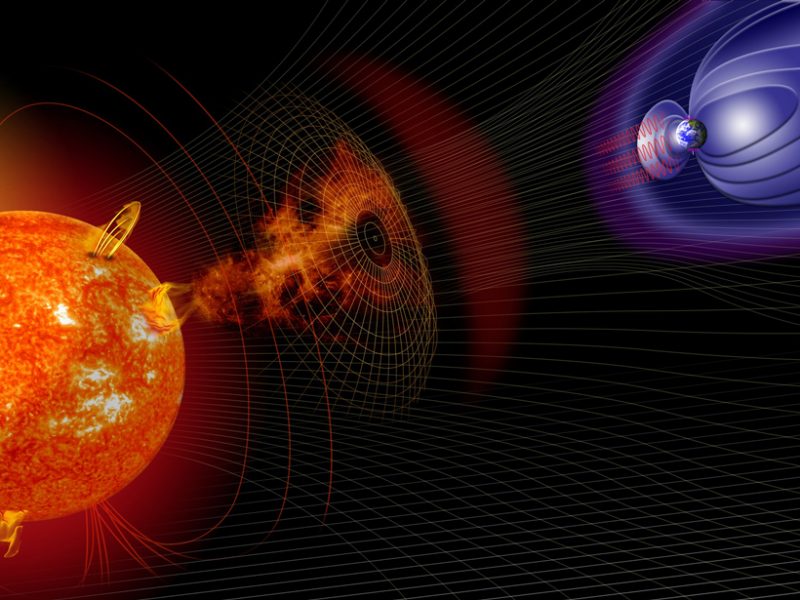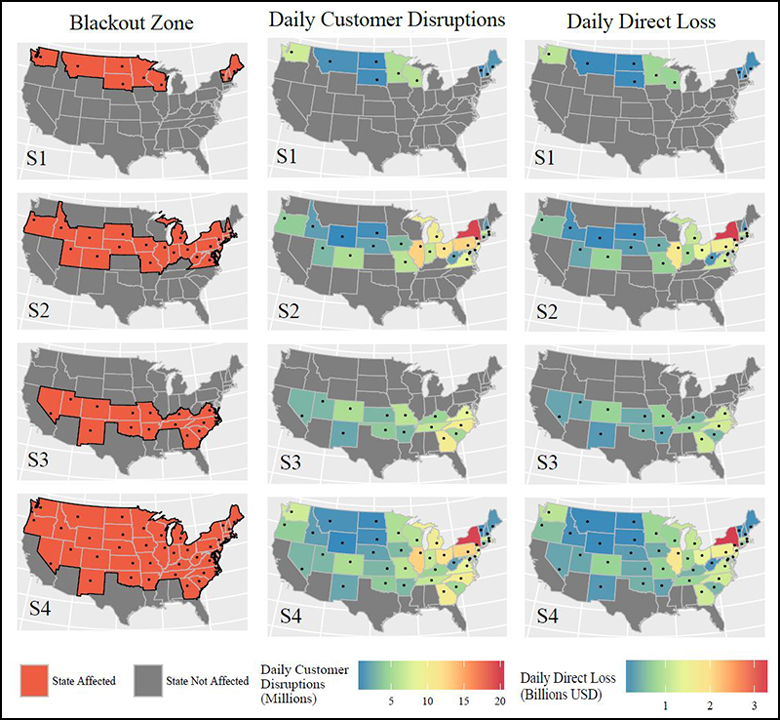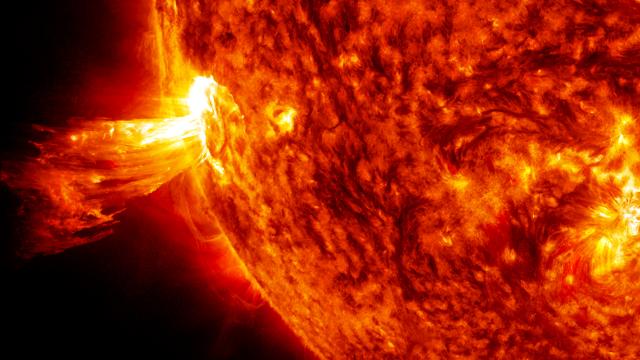Our planet is due to be hit with a powerful solar storm, an event that happens about once every hundred years. New research shows that losses from the ensuing blackouts could total $US41.5 billion ($54 billion) per day in the US alone, including nearly $US7 billion ($9 billion) lost in trade.
Image: NASA
A study published in Space Weather shows that a sufficiently powerful solar storm is capable of throwing the American economy into utter turmoil by knocking out the transformers required to transmit electricity throughout the nation’s power grids. Depending on the severity of the solar blast, the daily economic cost would be in the tens of billions of dollars, with more than half of those losses coming from indirect costs beyond immediately stricken regions.
Solar storms are space weather events in which the Sun, via coronal mass ejections (CMEs), spews any number of nasties our way, including X-rays, charged particles and magnetised plasma. Our high-tech civilisation is becoming increasingly vulnerable to the effects of these storms, which have the potential to knock out everything from handheld gadgets to the entire satellite fleet.
Our sun churns out these CMEs on a fairly regular basis, but due to their highly directional nature, our planet is often spared an ensuing geomagnetic storm. One of the more well known solar storms is the “Carrington Event” of 1859, which zapped telegraph wires, caused widespread communication outages and even ignited the Northern Lights as far south as Mexico and Cuba. In 1989, a geomagnetic storm triggered the electrical collapse of Canada’s Hydro-Quebec power grid and caused a widespread blackout that lasted for about nine hours. The probability of another Carrington-like event occurring within the next decade is estimated around 12 per cent.
Experts are split on the possible severity of blackouts caused by a CME. Some say the ensuing outages would be relatively brief, lasting only a few hours or days owing to the resilience of the existing transmission system. Others warn that blackouts could last weeks — or even months — because damaged transmission networks would need to be replaced.

Depiction of solar activity changing the conditions in near-Earth space. (Image: NASA)
The new paper, authored by researchers from the University of Cambridge’s Centre for Risk Studies, along with several other institutions, is an attempt to quantify the daily economic losses wrought by a sufficiently powerful geomagnetic storm. Unlike previous research, this study considers the collateral affects on global trade as a result of the blackouts.
“We felt it was important to look at how extreme space weather may affect domestic US production in various economic sectors, including manufacturing, government and finance, as well as the potential economic loss in other nations owing to supply chain linkages,” noted study co-author Edward Oughton in a statement. “It was surprising that there had been a lack of transparent research into these direct and indirect costs, given the uncertainty surrounding the vulnerability of electrical infrastructure to solar incidents.”

Chart showing the blackout zones, daily customer disruptions, and daily lost in GDP, according to different scenarios. (Image: AGU)
For the study, the researchers considered several different geographical scenarios for blackouts caused by severe space weather. If only the upper US states are affected — home to eight per cent of the US population — the economic loss per day could reach $US6.2 billion ($8 billion), plus nearly another billion lost by the disrupted international supply chain. A more severe storm affecting 23 per cent of the population could have a daily cost of $US16.5 billion ($21 billion), plus an additional $US2.2 billion ($2.9 billion) lost in trade. Most severely, a scenario affecting 44 per cent of the population could have a daily cost of $US37.7 billion ($49 billion), plus $US4.8 billion globally ($6 billion). In this most extreme scenario, it would take just 25 days to hit a trillion dollars in total losses. This horrendous loss of income would undoubtedly motivate the country into getting the power back up as quickly as possible.
A key finding was that the direct economic costs incurred from within a blackout zone represent only a fraction of the total cost. “On average in this study, only 49% of the total economic loss took place in the area affected by the storm, with a further 39% being lost indirectly in the U.S. outside of the blackout zone,” write the authors in the study. In total, 12 per cent of the impact would be felt internationally.
Prolonged blackouts would hit the US manufacturing sector the hardest, followed by government, finance and insurance (is extreme space weather even covered by insurance companies?) and property. A crippled America affect China the most, followed by Canada and Mexico.
Importantly, this analysis on focused on the United States. The authors rightly caution:
[In] reality we could be susceptible to a multiday, multiregional extreme space weather event. As a consequence, there is a need to undertake further economic impact assessment including Europe and East Asia, with multiple blackout zones, in order to understand the potential global cost associated with this threat.
It’s impossible to know when the next big geomagnetic storm will hit the Earth, or which regions of our planet will be most affected, but there are things you can do to prepare. As any prepper worth his or her grain of salt will tell you, you should have an emergency supply kit ready to go (don’t forget to pack extra batteries for the torches!), and a plan for getting in touch with loved ones. To spare your gadgets from the electromagnetic onslaught, you can build your own Faraday cage. And given the projected economic losses, you might want to hide a few dollars under your mattress.
